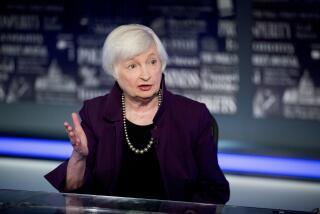As Markets Rise Again, So Do Analysts
- Share via
An analyst praises a company and its stock jumps 14%. Another says a company’s products are hot sellers and its shares bolt 26%. A third upgrades an entire industry sector and half a dozen stocks start to zoom.
Scenes from the 1999 stock-market bubble? Try scenes from the last couple of weeks.
As the equity market has revived since September, so has the influence of brokerage stock analysts.
It was only a few months ago that analysts were held up as symbols of Wall Street greed and venality. They were excoriated for their continually bullish pronouncements on risky technology stocks, even as the companies were losing money and the shares were crashing.
State and federal regulators launched investigations and Congress held hearings on the industry. Critics charged that various conflicts of interest had blackened the image of analysts. Amid the worst bear market in a generation, some experts questioned whether analysts ever would regain investors’ respect.
But as the market has rallied from three-year lows, the hand-wringing over credibility has given way to a fresh scramble to jump aboard companies that analysts are talking up.
“They are, as a group, as powerful as ever,” said Cynthia Dietzmann, a researcher at investment Web site Briefing.com who tracks analyst recommendations.
A case in point: On Dec. 19, shares of Tivo Inc., a San Jose-based maker of TV recording devices, meandered sideways for most of the morning.
But about 11:15 a.m., an analyst at investment bank Thomas Weisel Partners in San Francisco issued a report saying “strong word-of-mouth” was causing Tivo’s machines to sell out at many stores. The shares jumped as word of the report sped through Wall Street. The stock closed up 26%, at $5.68 on Nasdaq.
There are many reasons analysts retain enormous power, including that plenty of investors, large and small, simply want to believe someone else’s bullish view of a company’s prospects.
To be sure, some analysts have reputations as good stock pickers who do objective research, experts say. Their access to company managements and to the Wall Street rumor mill can provide useful information for money managers, though small investors rarely are first in line for the best tips.
But analysts’ continued influence also shines a spotlight on Wall Street’s system of touting not only stocks, but touting analysts themselves. Consider the process that takes place when analysts at big brokerage firms issue stock recommendations.
Large firms have extensive support staffs that are charged with drumming up interest in their analysts’ stock picks. Within minutes of a ratings upgrade or earnings-estimate boost, an army of stock brokers and institutional salespeople begin pitching the stock to their most active customers.
“There are a small number of firms where, when an analyst makes a ‘call,’ you have several thousand brokers who are immediately calling their best clients and telling them, ‘you should do X,’” said Sean Ryan, co-research director at Fulcrum Global Partners, a New York-based independent research firm. “In the short term, that can’t help but generate a large number of order tickets that are going to impact the stock price.”
Ryan was in the middle of an uproar over analyst independence last year when he resigned from brokerage Bear Stearns Cos. after a dispute with his bosses over his criticism of a major bank that did a lot of business with his firm.
Wall Street brokerages have defended their analysts, saying their rampant bullishness mirrored the optimism that permeated the market and the economy until early-2000. To be bullish in the late-1990s was to be right, the brokerages noted.
But critics argued that the analyst system had become corrupt. They charged that a virtual honeycomb of conflicts of interest prevented many analysts from doing objective research.
Analysts were accused of issuing upbeat reports merely to please the companies from which they hoped to lure lucrative investment-banking business. They also were criticized for not revealing personal investments in stocks they recommended--stakes that conceivably could have influenced their advice.
A pillar of the case against analysts was that few ever told clients to sell stocks, even as companies’ fundamentals deteriorated.
Historically, “sell” ratings have constituted fewer than 1% of analysts’ recommendations, according to First Call Corp., which tracks recommendations.
Since May 2000, the percentage of sell recommendations has tripled. But they still account for just 2.1% of the thousands of current recommendations. “Hold” continues to be the worst many brokerages will say about a stock.
This year’s meltdown of Enron Corp. raised fresh doubts about whether analysts can be relied upon. Even as the energy giant careened toward bankruptcy, many analysts continued to give the company favorable investment ratings.
For example, Credit Suisse First Boston kept a “strong buy” rating on the stock throughout its year-long slide, according to Investars.com, a Web site that tracks analyst stock picks. CSFB finally downgraded Enron to “hold” on Nov. 29--after the stock had fallen to 47 cents, according to Investars.com.
Just before the House held hearings on analyst objectivity in June, major brokerages agreed on a list of “best practices” that they promised would govern their stock research. The list included a pledge to use the “full ratings spectrum”--including “sell”--in evaluating stocks, and an agreement that analysts should not report to investment-banking departments of their firms. But the brokerages insisted they already complied with all of the key points.
In the summer, however, some firms announced new steps to bolster analysts’ credibility. Merrill Lynch, for example, banned its analysts from buying shares in companies they cover.
Al Jackson, head of global equity research at CSFB in New York, said analysts had not been “vigorous enough” in doing basic research in recent years and said his firm has a “rededication” toward objective work. Early in 2002, the firm will implement a new system in which analyst recommendations will place more emphasis on valuation, or a stock’s price relative to earnings and other fundamentals, he said.
Many investors have complained that analysts could have saved clients from technology stocks’ collapse over the last two years if classic warning signs of stock overvaluation had been observed.
But even if more analysts had suggested selling tech stocks at their peaks, would many clients have followed them, given the mania for the stocks at the time?
Amid the latest market rally, “buy” again appears to be what many investors want to hear most, some say.
Analysts wield power in part because their pronouncements can heighten whatever the prevailing market sentiment may be. And historically, investors’ bullish moods have far outlasted their bearish periods.
Many of the analyst community’s recent stock upgrades came after share prices already were rallying from their September lows. Thus, investors have been more receptive to the upbeat messages from analysts, said Kei Kianpoor, chief executive of Investars.com.
“[Investors] will hear ‘buy this’ and they don’t and it goes up 10%. And ‘buy that’ and they don’t and it goes up 20%,” Kianpoor said. “They might at a certain point say, ‘Hey, maybe this is my opportunity to make my money back’” from the losses racked up in the bear market.
Equally important, some professional investors acknowledge they must pay attention to analyst utterances simply because they believe other investors do.
“They’re tainted, but they still jerk the market around,” said mutual-fund manager Louis Navellier in Incline Village, Nev., who believes most analysts still are “cheerleaders.”
Because of brokerages’ hunger for investment-banking fees, suspicion about analysts’ intentions remains an underlying problem for Wall Street.
On Dec. 18, shares of business software maker Siebel Systems jumped 14% after Banc of America Securities analyst Bob Austrian boosted his revenue and earnings projections for the company.
Austrian’s firm was a co-manager of Siebel’s 1996 initial public offering and co-managed a convertible debt offering for the company in the fall of 1999.
Though Austrian said BofA naturally hopes to do more investment-banking work for Siebel, he said his latest report was based on good-faith analysis. Austrian said he had been critical of Siebel’s prospects early in the year--lowering his earnings estimates twice in a single week. His Siebel profit forecasts were consistently among the most conservative on Wall Street this year, he said.
“If the weatherman says it’s going to be sunny every day, eventually he loses the confidence of the viewers,” Austrian said. “You can’t do that. Nobody will listen to you.”
In any case, Austrian’s Siebel report had an effect beyond the investors who bought the stock that day.
The movement in the shares aroused the curiosity of Rimas Milaitis, manager of Strong Growth and Income stock mutual fund in Menomonee Falls, Wis. Though he didn’t trade Siebel shares that day, Milaitis nevertheless instructed his technology-stock specialist to “find out what all the excitement was.”
“We never go blindly into or out of a stock based on an analyst’s recommendation,” Milaitis said. But because they’re part of the market landscape, they can’t be ignored, he said.
As for analyst credibility, “some have it, some don’t,” he said. “It’s no different than any other industry.”
More to Read
Inside the business of entertainment
The Wide Shot brings you news, analysis and insights on everything from streaming wars to production — and what it all means for the future.
You may occasionally receive promotional content from the Los Angeles Times.










